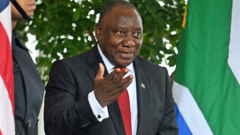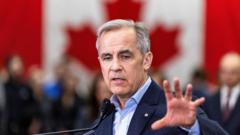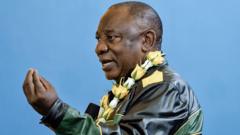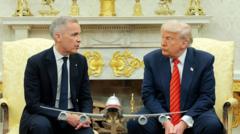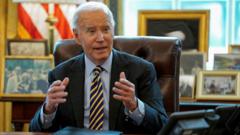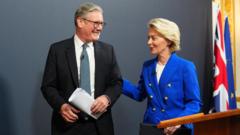**The article examines the spectrum of EU leaders’ reactions to the tariffs, the sectors most at risk, and the prospects for negotiation or retaliation.**
### EU's Response to Trump's New Tariffs: A Delicate Balancing Act

### EU's Response to Trump's New Tariffs: A Delicate Balancing Act
**As the EU grapples with the fallout from Donald Trump’s recent tariffs, leaders express concern over potential economic repercussions while contemplating responses.**
In a dramatic turn of global trade dynamics, Donald Trump has announced new tariffs impacting the European Union, igniting a flurry of reactions from top EU leaders. This unilateral decision has been characterized as "fundamentally wrong" by Germany’s outgoing chancellor Olaf Scholz, while Spanish Prime Minister Pedro Sánchez deemed it a “unilateral attack.” French President Emmanuel Macron lamented the “brutal” and “unfounded” nature of these tariffs, predicting a significant blow to the European economy.
In light of the 20% tariffs imposed specifically on EU goods sold to the US, Macron has swiftly called for an emergency meeting with impacted French industries, urging Europe not to make investments in the US until the situation finds resolution. Certain sectors such as wines, aeronautical products, luxury goods, and automobiles from France, Germany, and Italy may suffer greatly from these import taxes.
However, there are lesser-known sectors also at risk. French cognac, often overlooked as a staple, has gained popularity within the American music scene, with over 40% of French brandy exports going to the US. Spain’s exports of gas turbines and olive oil further highlight the diverse list of EU products and industries that could face severe consequences under the new tariffs.
Interestingly, some EU countries are more vulnerable than others to changes in trade dynamics. Ireland’s economy, heavily reliant on pharmaceutical and tech exports, sees one-fifth of its GDP linked to the US market, making it especially exposed. Research conducted in 2024 indicates that Germany has the highest dependence on the US among major EU economies, with over 5% of its GDP at stake, while Italy, France, and Spain follow suit with lower, but still significant, figures.
As the EU considers its reaction to Trump’s tariffs, coordination is taking place at its headquarters in Brussels. European Commission President Ursula von der Leyen asserts that the EU is well-equipped to negotiate and counteract the tariffs, given its status as one of the world’s largest single markets. Yet, with the US economy wielding significant power, the EU must navigate its retaliatory options delicately.
One proposed response is to focus on US services, potentially targeting tech giants like Apple and Amazon. However, the EU also faces complications in terms of maintaining energy supplies—a course that would be politically contentious, especially in the wake of recent geopolitical tensions.
The EU’s strategy appears to involve a mix of strategic threats of retaliation, soft calls for negotiations, and a hope that Trump might reconsider his stance on the tariffs. EU trade commissioner Maros Sefcovic is set to communicate with US officials as the situation develops, yet the EU is not rushing into immediate retaliation.
Potential negotiation offers from the EU to ameliorate the situation include increasing LNG imports from the US or committing to purchase more US military equipment; however, these options may clash with the EU’s internal strategic plans of boosting its own arms industry.
Amidst the discussions, the broader implications of global trade are weighing heavily on European leaders. Concerns arise regarding a potential trade war, particularly with China, as Trump intensifies tariffs against Beijing. This would compel the EU to rethink its import duties potentially leading to unfavorable consequences.
Finally, the European Commission is keen to address internal market barriers as a means of fortifying its economic stability during uncertain times. With a calculated aim to boost competitiveness across the single market, overcoming internal divisions remains a critical step as the EU grapples with external pressures from the unfolding tariff crisis.
In light of the 20% tariffs imposed specifically on EU goods sold to the US, Macron has swiftly called for an emergency meeting with impacted French industries, urging Europe not to make investments in the US until the situation finds resolution. Certain sectors such as wines, aeronautical products, luxury goods, and automobiles from France, Germany, and Italy may suffer greatly from these import taxes.
However, there are lesser-known sectors also at risk. French cognac, often overlooked as a staple, has gained popularity within the American music scene, with over 40% of French brandy exports going to the US. Spain’s exports of gas turbines and olive oil further highlight the diverse list of EU products and industries that could face severe consequences under the new tariffs.
Interestingly, some EU countries are more vulnerable than others to changes in trade dynamics. Ireland’s economy, heavily reliant on pharmaceutical and tech exports, sees one-fifth of its GDP linked to the US market, making it especially exposed. Research conducted in 2024 indicates that Germany has the highest dependence on the US among major EU economies, with over 5% of its GDP at stake, while Italy, France, and Spain follow suit with lower, but still significant, figures.
As the EU considers its reaction to Trump’s tariffs, coordination is taking place at its headquarters in Brussels. European Commission President Ursula von der Leyen asserts that the EU is well-equipped to negotiate and counteract the tariffs, given its status as one of the world’s largest single markets. Yet, with the US economy wielding significant power, the EU must navigate its retaliatory options delicately.
One proposed response is to focus on US services, potentially targeting tech giants like Apple and Amazon. However, the EU also faces complications in terms of maintaining energy supplies—a course that would be politically contentious, especially in the wake of recent geopolitical tensions.
The EU’s strategy appears to involve a mix of strategic threats of retaliation, soft calls for negotiations, and a hope that Trump might reconsider his stance on the tariffs. EU trade commissioner Maros Sefcovic is set to communicate with US officials as the situation develops, yet the EU is not rushing into immediate retaliation.
Potential negotiation offers from the EU to ameliorate the situation include increasing LNG imports from the US or committing to purchase more US military equipment; however, these options may clash with the EU’s internal strategic plans of boosting its own arms industry.
Amidst the discussions, the broader implications of global trade are weighing heavily on European leaders. Concerns arise regarding a potential trade war, particularly with China, as Trump intensifies tariffs against Beijing. This would compel the EU to rethink its import duties potentially leading to unfavorable consequences.
Finally, the European Commission is keen to address internal market barriers as a means of fortifying its economic stability during uncertain times. With a calculated aim to boost competitiveness across the single market, overcoming internal divisions remains a critical step as the EU grapples with external pressures from the unfolding tariff crisis.



